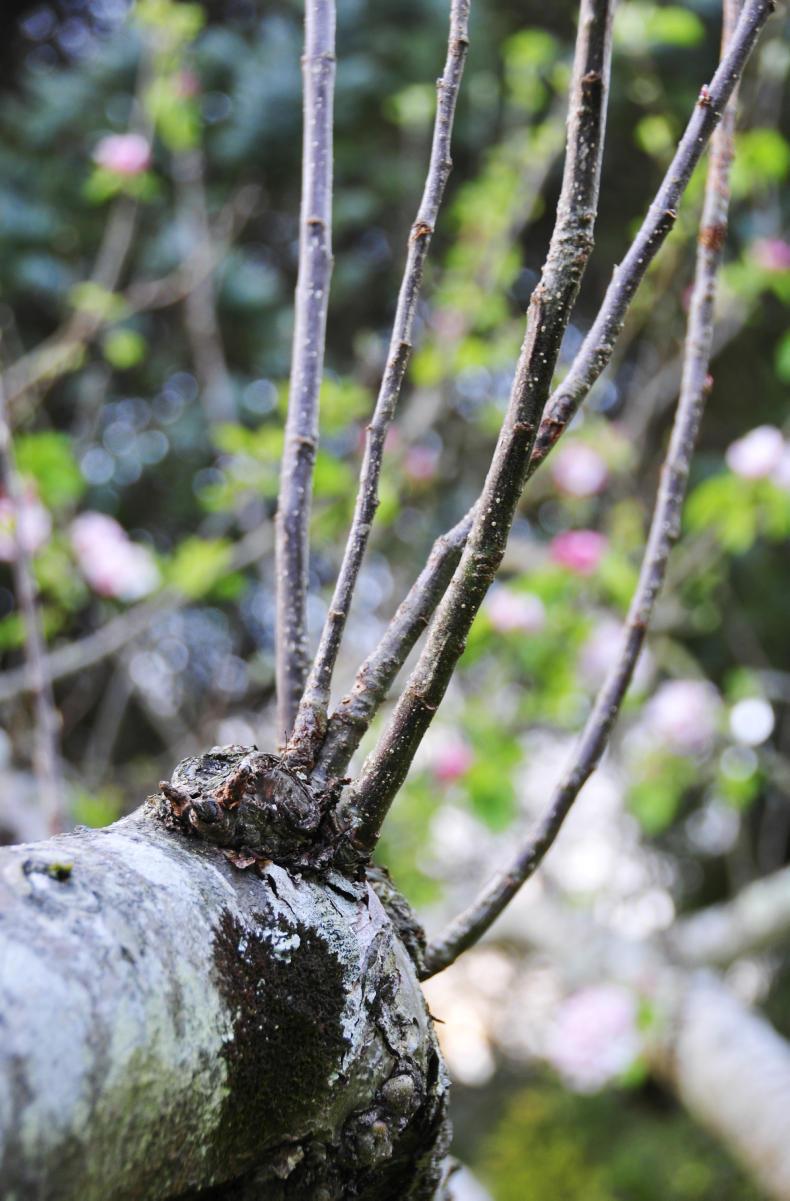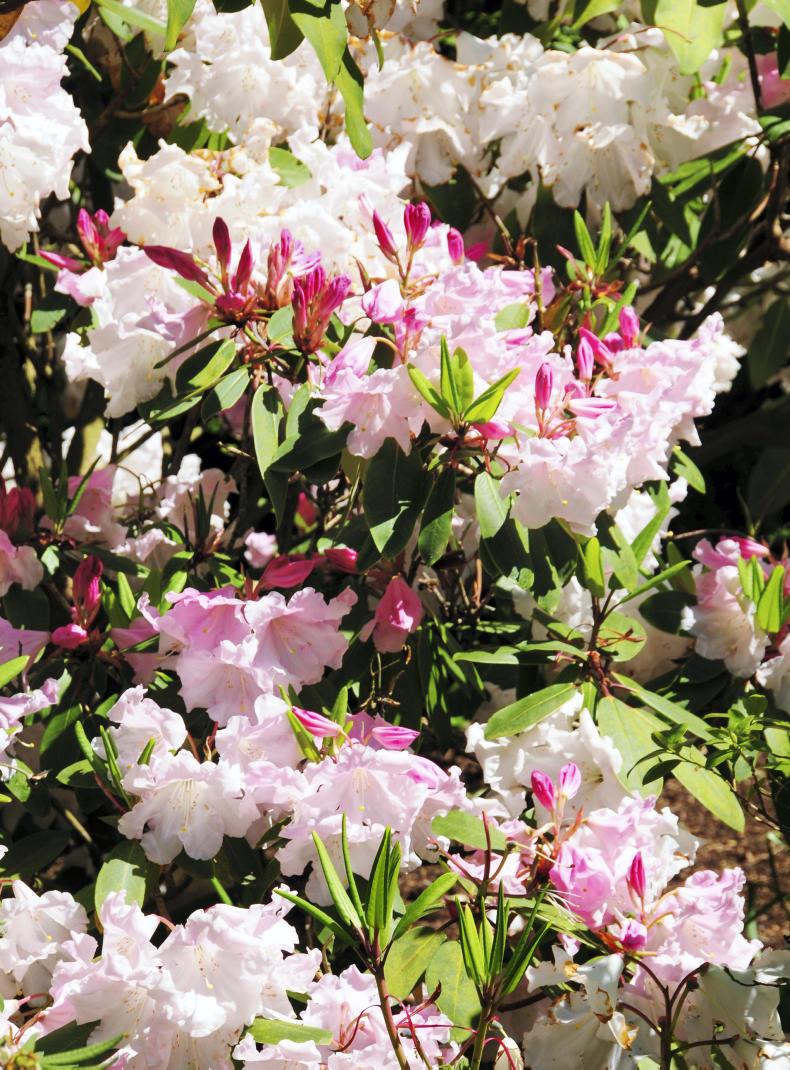One of the finest rhododendrons – and considered by some experts to be the finest – is Loder’s, Rhododendron x loderi.
They are not common, but not rare either. When one is seen in a garden, it is a reliable sign that the owners know more than a bit about plants.
This plant has the most strikingly beautiful show of flowers. Large trusses of up to 20 or more flowers are carried all over the top and sides.
Each flower, in turn, is a large trumpet-shape, as much as 10cm long and across.
Large flowers
These are some of the largest flowers rhododendrons carry, and are very fragrant. Walking along a garden path, and coming across one of these plants, is an unforgettable experience because they can be smelled before they are seen on a warm spring day.
Strange though it may seem, these plants are not natural wild species. The x in the middle of the two parts of the name indicates that these are hybrids or crosses.
Two Himalayan species were deliberately crossed to get the best characteristics of both parents. Rhododendron griffithianum is a beautiful species from warmer areas with huge flowers, but rather tender and prone to frost damage in Europe. It has peeling red-brown bark.
So, Rhododendron fortunei was chosen as the perfect parent because of its hardiness, vigour and fragrant flowers, which are also well-sized and more coloured pink-lilac than the partner species.
Difficult
Rhododendrons are noted for being easy to cross species of widely different size and growth habit, and the seeds are viable and easy to germinate and grow on. But still, somebody had to come up with the idea, – and that was Sir Edmund Loder, a rhododendron enthusiast.
He made the first controlled crosses of these species in 1901.
These crosses quickly became famous and sought-after, so much so that most gardens with a rhododendron collection have the hybrid somewhere, often by a path because of the scent and the likelihood is that people beat a path towards the source of the scent.
The fortunei parent is really a small tree or very big bush, to 10m tall in perfect conditions, and quite a sight. However, for most people who plant one, it will take a few years to reach 2m and decades to reach full size.
Space
So it is for a large garden with space to be seen. There is not much point in squeezing it into a small area if you cannot admire it properly. A full-size tulip magnolia is a good comparison for size and outline.
These crosses need good, deep, acidic soil, shelter, a little overhead cover by tall trees, but still good sunshine hours.
Considered by many to be the best of named crosses, ‘King George’ is a real beauty. Its large buds over medium-large leaves open in a lovely rich shade of light raspberry red.
As the buds unfurl, the pink suffuses the flower trumpets. Eventually, the pink is washed out and the flowers are crystalline white.
‘Venus’ has more pink colouring than ‘King George’, but has the same transition from darker buds to softer flowers.
Both of these have broad trusses, fairly loose in structure.
‘Loder’s White’ is pure white with a taller, more conical truss of flowers. It is fragrant but not as fragrant as the others. The scent is sweet but not cloying, powerful but light and very exotic.
When apple trees have been pruned hard or are over-fed and growing in rich soil, they often produce fast-growing stems know as “water shoots” because they are soft and extended.
However, it they are left in position they soon get woody and become more difficult to remove.

Apple water shoots.It is the tree’s reaction to loosing branches and the effect of sunlight falling on the bigger limbs, trying to re-build pruned branches.
These shoots are much more prone to scab disease because they are soft and can be more easily attacked by fungi.
Break them off by hand while they are small and cut them cleanly if they have become woody and hard to shift.
Read more
Gardening jobs to do this week
Gardening: Blue-purple honeywort
One of the finest rhododendrons – and considered by some experts to be the finest – is Loder’s, Rhododendron x loderi.
They are not common, but not rare either. When one is seen in a garden, it is a reliable sign that the owners know more than a bit about plants.
This plant has the most strikingly beautiful show of flowers. Large trusses of up to 20 or more flowers are carried all over the top and sides.
Each flower, in turn, is a large trumpet-shape, as much as 10cm long and across.
Large flowers
These are some of the largest flowers rhododendrons carry, and are very fragrant. Walking along a garden path, and coming across one of these plants, is an unforgettable experience because they can be smelled before they are seen on a warm spring day.
Strange though it may seem, these plants are not natural wild species. The x in the middle of the two parts of the name indicates that these are hybrids or crosses.
Two Himalayan species were deliberately crossed to get the best characteristics of both parents. Rhododendron griffithianum is a beautiful species from warmer areas with huge flowers, but rather tender and prone to frost damage in Europe. It has peeling red-brown bark.
So, Rhododendron fortunei was chosen as the perfect parent because of its hardiness, vigour and fragrant flowers, which are also well-sized and more coloured pink-lilac than the partner species.
Difficult
Rhododendrons are noted for being easy to cross species of widely different size and growth habit, and the seeds are viable and easy to germinate and grow on. But still, somebody had to come up with the idea, – and that was Sir Edmund Loder, a rhododendron enthusiast.
He made the first controlled crosses of these species in 1901.
These crosses quickly became famous and sought-after, so much so that most gardens with a rhododendron collection have the hybrid somewhere, often by a path because of the scent and the likelihood is that people beat a path towards the source of the scent.
The fortunei parent is really a small tree or very big bush, to 10m tall in perfect conditions, and quite a sight. However, for most people who plant one, it will take a few years to reach 2m and decades to reach full size.
Space
So it is for a large garden with space to be seen. There is not much point in squeezing it into a small area if you cannot admire it properly. A full-size tulip magnolia is a good comparison for size and outline.
These crosses need good, deep, acidic soil, shelter, a little overhead cover by tall trees, but still good sunshine hours.
Considered by many to be the best of named crosses, ‘King George’ is a real beauty. Its large buds over medium-large leaves open in a lovely rich shade of light raspberry red.
As the buds unfurl, the pink suffuses the flower trumpets. Eventually, the pink is washed out and the flowers are crystalline white.
‘Venus’ has more pink colouring than ‘King George’, but has the same transition from darker buds to softer flowers.
Both of these have broad trusses, fairly loose in structure.
‘Loder’s White’ is pure white with a taller, more conical truss of flowers. It is fragrant but not as fragrant as the others. The scent is sweet but not cloying, powerful but light and very exotic.
When apple trees have been pruned hard or are over-fed and growing in rich soil, they often produce fast-growing stems know as “water shoots” because they are soft and extended.
However, it they are left in position they soon get woody and become more difficult to remove.

Apple water shoots.It is the tree’s reaction to loosing branches and the effect of sunlight falling on the bigger limbs, trying to re-build pruned branches.
These shoots are much more prone to scab disease because they are soft and can be more easily attacked by fungi.
Break them off by hand while they are small and cut them cleanly if they have become woody and hard to shift.
Read more
Gardening jobs to do this week
Gardening: Blue-purple honeywort







 This is a subscriber-only article
This is a subscriber-only article






SHARING OPTIONS: